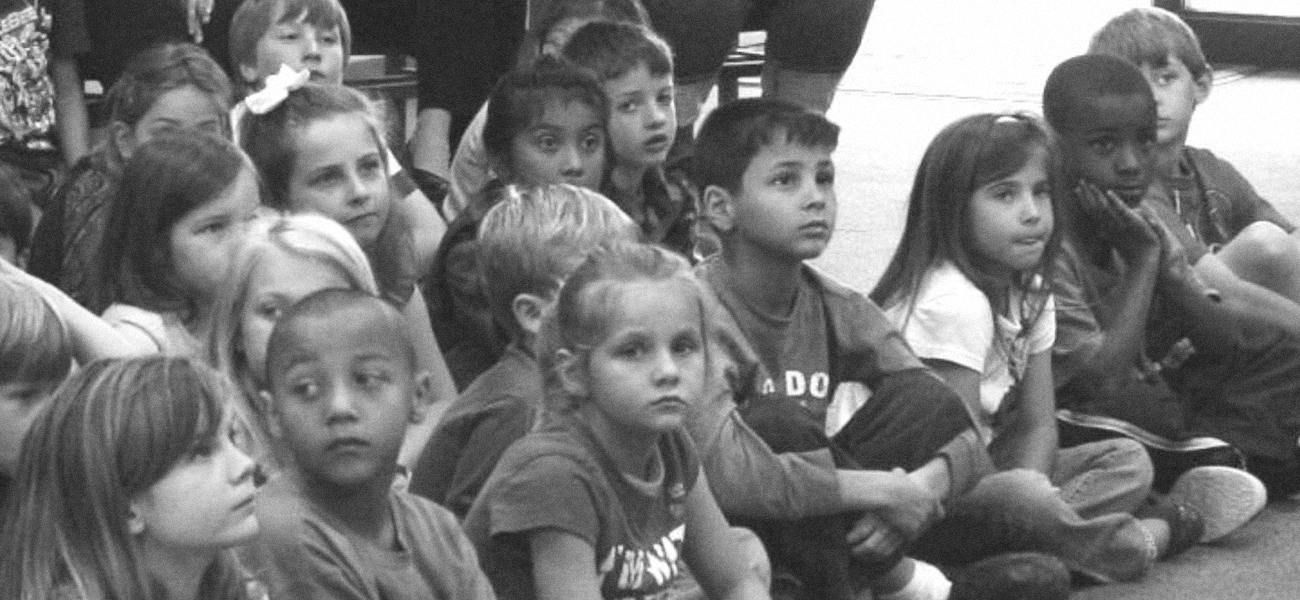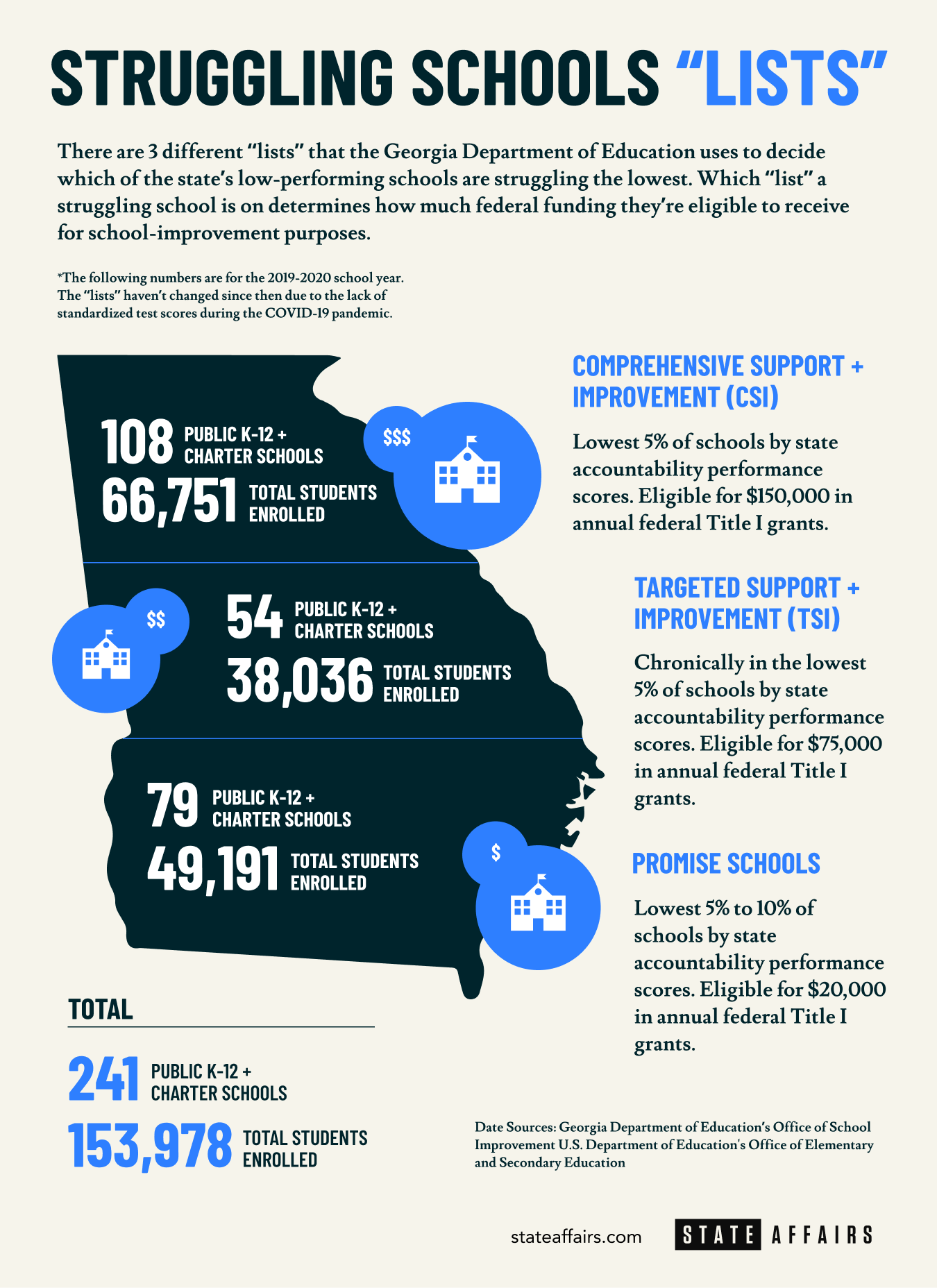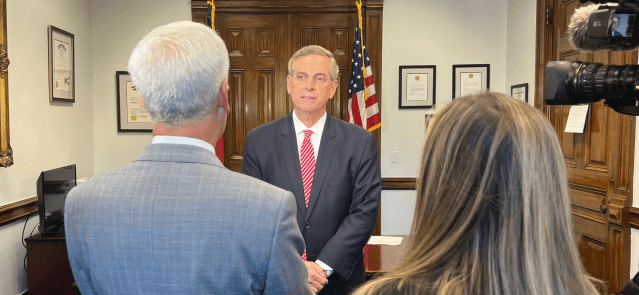Stay ahead of the curve as a political insider with deep policy analysis, daily briefings and policy-shaping tools.
Request a Demo
Credit: Governor's Office of Student Achievement
- 1 in 17 kids in Georgia attend low-performing public schools.
- Georgia in bottom half of states in per-student spending in 2019.
- Low math and reading test scores in Georgia vs. most states.
Georgia struggles to stretch its tax dollars when it comes to turning around test scores and graduation rates for thousands of students in low-performing public schools.
More than 1.7 million students were enrolled in roughly 2,250 public and charter schools in Georgia during the 2020 spring semester, around when the pandemic sent students home for virtual learning that March. Beyond health care and public safety, perhaps nothing touches the daily lives of more Georgians across the state than the successes and failures of publicly funded schools.
And for those students and their families, few areas raise more concerns than the struggles of low-performing schools in dozens of local communities hit hard by poverty, isolation, and the COVID-19 pandemic.

Around 1 in 17 kids in the state attend schools that fall among the bottom 5% in terms of standardized test scores, graduation rates and other factors like discipline and student health.
That’s more than 100,000 students in roughly 160 severely struggling schools, plus another 50,000 or so in other schools that only recently started turning the academic tide.
These schools qualify for millions of dollars in federal aid on top of what the state budgets for its Office of School Improvement, tasked with divvying up federal funds and sending out education specialists to work with teachers, administrators and students at struggling schools. Every penny helps.

(Credit: Brittney Phan for State Affairs)
Georgia has one of the highest populations of any state in the country, along with a large number of public school students who make up its population.
Of the state’s roughly 10.6 million people as of 2019, around 16% are K-12 students, according to U.S. Census Bureau data. The large population complicates how much the state can spread dollars to cover essential school services, such as teacher salaries, classroom materials and special-education support.
While Georgia spent more on schools overall than most states in 2019, at roughly $19.5 billion, that translated to a comparatively low average of $11,228 spent on each student. Compared to other states, Georgia ranked 34th in per-student spending from federal, state and local dollars, Census data shows.

(Credit: Georgia Department of Education)
Georgia’s per-student spending tracked closely with how local schools fared on federally required test scores in 2019 compared to other states.
That’s according to data collected as part of the National Assessment of Educational Progress, which tests a sample of students from different demographic and economic backgrounds across the U.S. to assess academic performance trends.
Georgia ranked 35th compared to other states in fourth grade reading comprehension and math scores, as well as in eighth grade reading, according to the 2019 reports. The state also ranked 37th in eighth grade reading scores and 36th in eighth grade math.
Many of Georgia’s lowest-performing schools saw less per-student spending during the 2019-20 year than the state average, rounding out to $10,698 for about 50 schools with years of low test scores and graduation rates. Some of those schools spent less than $9,000 per student.

(Credit: Georgia Department of Education)
Some of Georgia’s weakest test scores come from schools in metro Atlanta, Macon and Savannah and many rural areas that fall in the lowest 5% of all schools in academic achievement, qualifying them for federal grants under the Every Student Succeeds Act.
That act, passed in 2015, requires each state to identify its bottom 5% of schools, paving the way for them to receive federal school-improvement grants. Close to 170 local schools nabbed a total of roughly $39 million in grants for the 2019-20 school year, mostly from federal sources.
Those funds went toward buying data-analysis equipment and classroom materials, setting up after-school programs and leadership training, and hiring new staff like teachers, social workers and behavioral specialists.

(Credit: Clayton County Public Schools)
Morcease Beasley, the superintendent of Clayton County Public Schools, said those resources aim to help schools bring struggling students up to reading and learning math at grade level.
Many students fall behind in those subjects due partly to outside factors like poverty, he said.
“Poverty is a factor that has great implications for what we do,” Beasley said in a recent interview.
“Our work of improvement is knowing where these kids are when they come to us, figuring out specifically what their needs are, what data are we going to collect along the way, providing those supports consistently, and monitoring that process to ensure that students continue growth.”
More than 1.2 million students in Georgia are considered “economically disadvantaged,” meaning they qualify for free or low-cost meals since their families earn incomes either just above or below the federal poverty line, according to data from the state Governor’s Office of Student Achievement.
Many of those students attend about two dozen schools that came under supervision of the state’s short-lived Chief Turnaround Office.
Lawmakers created the program in 2017 as a quasi-independent program to add to work already being done by the Georgia Department of Education’s school-improvement division. In the roughly three years that the turnaround program existed, it sent a team of education specialists to work one-on-one with teachers and administrators on analyzing performance data, creating improvement plans and completing leadership training.
The program, which served nearly 10,000 students total, managed to boost progress scores for more than half of its schools before folding in 2020, due mainly to political influences and internal strife.
Going forward, the work to pull up test scores and graduation rates in Georgia’s struggling schools continues for the state school-improvement division, currently budgeted this year for about $16.7 million in state and federal funds.
That division does not have the authority to give the state control over struggling schools, such as would have been the case under a program called the Opportunity School District that lawmakers passed in 2015, but Georgia voters scrapped before its launch. Instead, many struggling schools that show little progress in boosting scores and graduation rates risk losing so-called state strategic waivers, which let them use benchmarks for teacher evaluations and student performance that don’t strictly match federal requirements.
Despite that stick, state education officials try not to punish chronically under-performing schools, said Meghan Frick, spokeswoman for the state Department of Education.
“In general, our focus is not on punitive measures but on working directly with schools to ensure improvement,” Frick said.
State school-improvement specialists, as well as outside coaches hired by local districts, are now taking stock of the pandemic’s impacts on academic progress in schools that struggled long before COVID-19 hit Georgia.
The state has not updated its official list of struggling schools since the 2019-20 school year, due partly to the lack of standardized test scores that officials nixed during the early months of the pandemic.
Educators and advocates from several local school-focused groups have also started examining the pandemic’s effects on student achievement, including beyond just test scores in areas like health, wellness and grade-level learning progress. Those groups should know better how Georgia students fared during the pandemic via a report assessing academic progress other than test scores that’s set to wrap up in the coming months, said Craig Harper, executive director of the Professional Association of Georgia Educators.
“It’s going to be such a mixed bag of test results because of the pandemic,” Harper said in a recent interview. “We’re all anxious to see how schools start the upcoming year.”
What else would you like to know about Georgia’s public schools? Share your thoughts/tips by emailing [email protected].
Header image courtesy of the Governor’s Office of Student Achievement
Georgia defies bomb threats as election chief declares a “free, fair and fast” vote amid record turnout
ATLANTA – Despite dealing with over 60 bomb threats, Georgia’s election chief said Tuesday the state’s general election went smoothly. Georgia had a record turnout with nearly 5.3 million people voting, Secretary of State Brad Raffensperger told reporters. Election officials in the state’s 159 counties have until 5 p.m. to certify votes. “We had a …
In the (state)house: Meet the newest members of the Georgia legislature
When lawmakers reconvene at the state Capitol on Jan. 13, there’ll be a cadre of new faces in the 236-member Georgia General Assembly, one of the nation’s largest state legislatures. All 236 statehouse seats were up for election this year. Most candidates ran unopposed. Incumbents in contested races easily kept their seats, with the exception …
2 young Democrats win Statehouse seats as Republicans hold majority
ATLANTA — Many Statehouse incumbents appeared to beat back challengers Tuesday, ensuring their return to the Capitol in January. Republicans retain control of the House and Senate. Two Generation Z candidates will join the 236-member Legislature as new members of the House of Representatives: Democrats Bryce Berry and Gabriel Sanchez. Berry, a 22-year-old Atlanta middle …
Election night 2024: What to watch for as the results roll in
It’s been a long time coming, but we’ve finally made it to Election Day 2024. Today’s most anticipated race is, of course, the presidential contest between Vice President Kamala Harris and former President Donald Trump. The pair have spent a combined $25 million in new media ads alone in the past two weeks in this …




